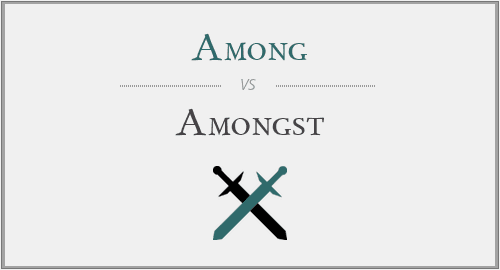In the Midst of Choice: Among versus Amongst
Contents

Ever been writing an email to your team and got stuck. Maybe deciding if you should use "the responsibility is shared among us" or "the responsibility is shared amongst us"? You're not alone, and this post is here to help.
We'll clear up the confusion between 'among' and 'amongst'. Though it might seem small, getting it right can improve your communication in English. We'll look at the difference between the two, provide examples, and explain when to use among vs amongst.
By the end of this post, you'll know how to use 'among' and 'amongst' correctly, helping you speak and write English more confidently. Let's get started!
What Do 'Among' and 'Amongst' Mean?
'Among' and 'Amongst' are words that connect nouns to other parts of a sentence. Both mean being in the middle of or surrounded by something, showing a kind of group connection.
For instance:
Among: "I found my phone among the books on my desk."
Amongst: "He felt at ease amongst his friends."
Here, 'among' and 'amongst' mean being surrounded by things or people. The choice between them today is mainly about style.
Understanding 'Among' and 'Amongst'
Here are some points on using 'among' and 'amongst':
Use them when talking about three or more things.
'Among' is more common today.
'Amongst' sounds more formal or old-fashioned.
For example:
Sharing snacks with friends, you might say: “The samosas were shared among all guests.”
In a story from the Mughal era, it might read: “The prince walked amongst his loyal subjects.”
When Should You Use Among Vs Amongst?
Thinking over among vs amongst usage? The choice between these words depends largely on the context. Although both indicate being surrounded by or in the company of others, 'among' is often used in modern English. While 'amongst' resonates with traditional, poetic, or formal contexts.
Let's illustrate this with dialogue snippets:
Ravi found himself among friends at the party.
She was amongst the first to arrive at the meeting.
The among vs amongst difference lies subtlely in their vibes. 'Among' sounds more casual and contemporary, while 'amongst' feels formal or even old-fashioned.
Word | Scenario | Usage |
Among | Casual conversation | "He sat among his colleagues." |
Amongst | Formal writing or speech | "She is amongst those shortlisted for the prize." |
This shows how the setting can change which word you use. For more tips on using words like these, check out the Clapingo blog.
Among Vs. Amongst in UK and US English
To define among vs amongst, it's crucial to consider geography. British English often leans towards 'amongst', whereas American English prefers 'among'.
For instance:
British: The Queen distributed presents amongst her grandchildren.
American: The President moved among the crowd.
However, remember that these are general tendencies rather than firm rules!
When looking at among vs amongst grammar, remember that both are prepositions giving a sense of being part of a larger group. Understanding this improves your overall grasp on among vs amongst meaning.
Common Mistakes While Using 'Among' and 'Amongst'

Non-native English speakers frequently mix up 'among' and 'amongst.' Here are some common errors:
Interchangeable usage:
Many believe these two words can be swapped at will. This is not entirely correct. While they have similar meanings, 'amongst' is used more in British English and is viewed as more formal.
Incorrect preposition choice:
When unsure, some learners use neither among nor amongst. They replace them with other prepositions like between or around. This can lead to grammatical errors.
Misuse with singular nouns:
Both 'among' and 'amongst' should be used with plurals or groups of people or things. Using them with singular nouns is a mistake.
To avoid these mistakes, remember to practice among vs amongst usage correctly. Use them for indicating relationships within a group, stick to 'among' for a casual or American context and use 'amongst' when writing formally or in British English.
How Clapingo Can Support Your English Language Learning Journey
Understanding the among vs amongst difference can boost your confidence while speaking or writing English. It's details like these that matter when you're striving for fluency and clarity of expression.
At Clapingo, we offer personalized coaching sessions to help you navigate these subtleties of the language. Our qualified tutors focus on improving your understanding and application to improve your personal and professional interactions.
We believe in learning at your own pace, so our sessions are adaptable to suit your comfort level. Whether you are a working professional or a student, Clapingo can be your guide.
To Sum Up
We explored 'Among vs Amongst' and they mean similar things. Both "among" and "amongst" show when something is with others or part of a group.
However, 'among' is more popular today, especially in India. 'Amongst' is often used in older texts, formal writing, and British English. Knowing the difference helps improve your confidence. Try to use both words in conversations to get comfortable with them.
Practising is key to learning any language, and you don't have to struggle to practice.
Clapingo offers coaching sessions for non-native speakers to help with words like 'among' and 'amongst.' With Clapingo, you can learn more about English grammar and vocabulary in a way that's customised for you. Join us on this learning journey to become a better English speaker!
FAQs
1. Is there a difference between 'among' and 'amongst'?
Both 'among' and 'amongst' are prepositions that indicate sharing or distribution. However, the difference between them lies in their usage and preference. 'Among' is more commonly used in modern English, especially American English. While 'amongst' tends to be preferred in British English.
2. Can I interchangeably use 'among' and 'amongst'?
Yes, you can interchangeably use 'among' and 'amongst'. But it's essential to understand the context and the regional preferences. For instance, if you're speaking with an American audience, you might want to use 'among'. But with a British crowd, you might prefer using 'amongst'.
3. When should I use 'among' or 'amongst'?
You can use both these prepositions when referring to three or more things in a non-specific way. The choice between them often comes down to stylistic preference or regional norms. Although either choice will generally be understood by English speakers worldwide.
Comments
Your comment has been submitted successfully!